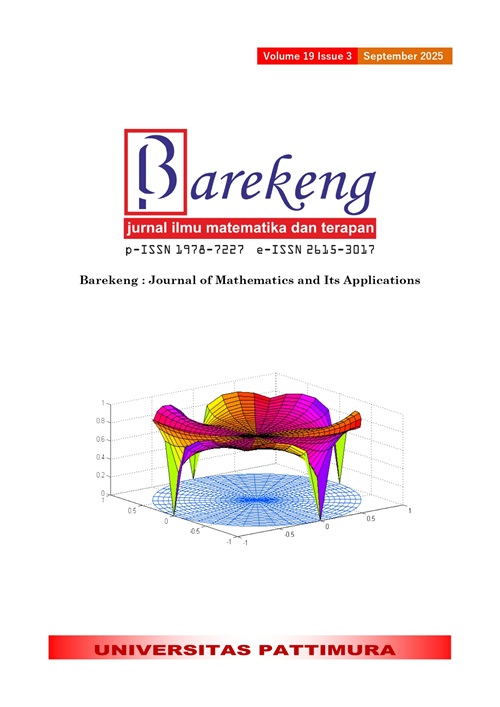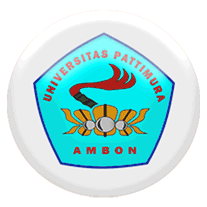SPATIAL INTERPOLATION OF RAINFALL INTENSITY IN JAVA ISLAND USING ORDINARY KRIGING
Abstract
Indonesia, situated between two continents and two oceans, experiences a complex climate system influenced by global warming. Climate change has disrupted weather patterns, making it increasingly difficult to predict the rainy and dry seasons and rainfall intensity. However, neighboring regions often exhibit similar weather characteristics, which can be leveraged for prediction. As Indonesia’s economic center, Java Island displays distinct yet interconnected weather patterns, making accurate rainfall prediction crucial for various sectors. This study utilizes 10 years of average rainfall data from NASA’s Power database, covering 64 observation points across Java. Ordinary point kriging is the estimation of a value at a given point and is often used in spatial interpolation analysis in general. Through ordinary point kriging analysis, this study aims to find an accurate kriging equation for predicting rainfall in various regions of Java Island. To achieve this, semivariogram modeling was performed to determine the best theoretical model for spatial interpolation. From 53 sampled regions, 1,378 sample pairs were used to calculate the experimental semivariogram obtained using the R programming language. Next, the theoretical semivariogram was determined using the sill parameter derived from the variance of the sampled data. Three theoretical semivariogram models were considered: spherical, exponential, and Gaussian. The results indicated that the exponential model was the most suitable as it had the smallest SSE value. The results of this analysis enrich our understanding of climate patterns in Indonesia and will contribute to developing mitigation and adaptation strategies related to climate change in the future. The Kriging equation obtained can provide highly accurate prediction results on the test data with a MAPE (Mean Absolute Percentage Error) error measure of 4.85% and RMSE (Root Mean Square Error) of 18.17, which indicates that the prediction results obtained are highly accurate predictions.
Downloads
References
A. Noviyani, T. Nopsopon, and K. Pongpirul, “VARIATION OF TUBERCULOSIS PREVALENCE ACROSS DIAGNOSTIC APPROACHES AND GEOGRAPHICAL AREAS OF INDONESIA,” PLoS One, vol. 16, no. 10 October, Oct. 2021.doi: https://doi.org/10.1371/journal.pone.0258809
E. Runtunuwu and D. H. Syahbuddin, “PERUBAHAN POLA CURAH HUJAN DAN DAMPAKNYA TERHADAP PERIODE MASA TANAM,” 2007.
A. Arif, “PERUBAHAN POLA HUJAN DI JAKARTA DALAM SEABAD DAN IMPLIKASINYA,” kompas.id. Accessed: April 21, 2024. [Online]. Available at: https://www.kompas.id/baca/ilmu-pengetahuan-teknologi/2022/04/18/perubahan-pola-hujan-di-jakarta-dalam-seabad-dan-implikasinya.
CNN Indonesia, “BPS: PEREKONOMIAN INDONESIA MASIH TERPUSAT DI PULAU JAWA,”, CNN Indonesia, 05-05-2023. Accessed: May 24, 2024. [Online]. Available at: https://www.cnnindonesia.com/ekonomi/20230505113652-532-945647/bps-perekonomian-indonesia-masih-terpusat-di-pulau-jawa.
Universitas Gadjah Mada, “BANYAK FAKTOR PENGARUHI TINGGINYA CURAH HUJAN,” Universitas Gadjah Mada, 20-Apr-2022. [Online]. Available: https://ugm.ac.id/id/berita/22459-pengamat-ugm-banyak-faktor-pengaruhi-tingginya-curah-hujan/. [Accessed: 30-Mar-2025].
A. B. Sekaranom, E. Nurjani, and F. Nucifera, “AGRICULTURAL CLIMATE CHANGE ADAPTATION IN KEBUMEN, CENTRAL JAVA, INDONESIA,” Sustainability (Switzerland), vol. 13, no. 13, Jun. 2021.doi: https://doi.org/10.3390/su13137069
R. Rahayu, S. A. Mathias, S. Reaney, G. Vesuviano, R. Suwarman, and A. M. Ramdhan, “IMPACT OF LAND COVER, RAINFALL AND TOPOGRAPHY ON FLOOD RISK IN WEST JAVA,” Natural Hazards, vol. 116, no. 2, pp. 1735–1758, Mar. 2023.doi: https://doi.org/10.1007/s11069-022-05737-6
B. D. A. Nugroho, C. Arif, F. Suryandika, H. N. Annisa, and S. I. Wijayanti, “RELATIONSHIPS AMONG GLOBAL CLIMATE INDICES, RAINFALL PATTERNS, AND CROP PRODUCTIVITY IN THE SOUTHERN PART OF JAVA, INDONESIA,” Ecological Engineering & Environmental Technology, vol. 25, no. 10, pp. 87–95, Oct. 2024.doi: https://doi.org/10.12912/27197050/191332
M. Harris, “BATAS LAUT PULAU JAWA,” Accessed: April 21, 2024. [Online]. Available at: https://www.gramedia.com/literasi/batas-laut-pulau-jawa/.
H. Chandra and H. Suprapto, “SISTEM INFORMASI INTENSITAS CURAH HUJAN DI DAERAH CILIWUNG HULU,” Jurnal Informatika dan Komputer, vol. 21, no. 3, 2016.
R. Amelia, E. Julianti, and Guskarnali, “IMPLEMENTATION OF INVERSE DISTANCE WEIGHTING (IDW) AND KRIGING METHOD FOR DISTRIBUTION PATTERN HUMIDITY AND TEMPERATURE DATA ON WEATHER CHANGES IN THE BANGKA ISLANDS,” in IOP Conference Series: Earth and Environmental Science, Institute of Physics, 2023.doi: https://doi.org/10.1088/1755-1315/1267/1/012091
S. P. Sejati, “PERBANDINGAN AKURASI METODE IDW DAN KRIGING DALAM PEMETAAN MUKA AIR TANAH,” Majalah Geografi Indonesia, 2019.
G. Chen, Y. Yang, X. Liu, and M. Wang, “SPATIAL DISTRIBUTION CHARACTERISTICS OF HEAVY METALS IN SURFACE SOIL OF XILINGUOLE COAL MINING AREA BASED ON SEMIVARIOGRAM,” ISPRS Int J Geoinf, vol. 10, no. 5, May 2021.doi: https://doi.org/10.3390/ijgi10050290
E. H. Isaaks and R. M. Srivastava, “APPLIED GEOSTATISTICS,” 1989.
A. N. Falah et al., “AN EXPANDED SPATIAL DURBIN MODEL WITH ORDINARY KRIGING OF UNOBSERVED BIG CLIMATE DATA,” Mathematics, vol. 12, no. 16, Aug. 2024.doi: https://doi.org/10.3390/math12162447
E. Ashrafpour, “DIFFERENCE BETWEEN SIMPLE KRIGING AND ORDINARY KRIGING,” Mar. 2021.
J.-M. Montero, G. Fernández-Avilés, and J. Mateu, SPATIAL AND SPATIO-TEMPORAL GEOSTATISTICAL MODELING AND KRIGING, 1st ed. Wiley, 2015.
S. Salsabilla, A. F. Syaharni, and N. Chamidah, “ENTHUSIASTIC INTERNATIONAL JOURNAL OF APPLIED STATISTICS AND DATA SCIENCE PREDICTION OF PM2.5 IN DKI JAKARTA USING ORDINARY KRIGING METHOD,” Enthusiastic International Journal of Applied Statistics and Data Science, vol. 3, no. 1, pp. 48–58, 2023.doi: https://doi.org/10.20885/enthusiastic.vol3.iss1.art5
A. N. Falah, “SPATIAL AUTOREGRESSIVE EXOGENOUS KRIGING CLUSTERING MODEL AND ITS APPLICATION TO CLIMATE DATA IN INDONESIA,” Padjadjaran University, 2024.
D. A. Lubis and S. Fauziah, “METODE ORDINARY POINT KRIGING UNTUK MEMPREDIKSI INFLASI DI KABUPATEN/ KOTA YANG TIDAK TERSAMPEL,” Jurnal Litbang Sukowati, vol. 2, pp. 36–48, 2018.doi: https://doi.org/10.32630/sukowati.v2i1.41
Copyright (c) 2025 Shabira A. Auliyazhafira, Fariza A. Putri, Theresia S. Nauli, Aulia R. Al Madani, I Gede Nyoman Mindra Jaya, Annisa N. Falah, Budi Nurani Ruchjana

This work is licensed under a Creative Commons Attribution-ShareAlike 4.0 International License.
Authors who publish with this Journal agree to the following terms:
- Author retain copyright and grant the journal right of first publication with the work simultaneously licensed under a creative commons attribution license that allow others to share the work within an acknowledgement of the work’s authorship and initial publication of this journal.
- Authors are able to enter into separate, additional contractual arrangement for the non-exclusive distribution of the journal’s published version of the work (e.g. acknowledgement of its initial publication in this journal).
- Authors are permitted and encouraged to post their work online (e.g. in institutional repositories or on their websites) prior to and during the submission process, as it can lead to productive exchanges, as well as earlier and greater citation of published works.






1.gif)



